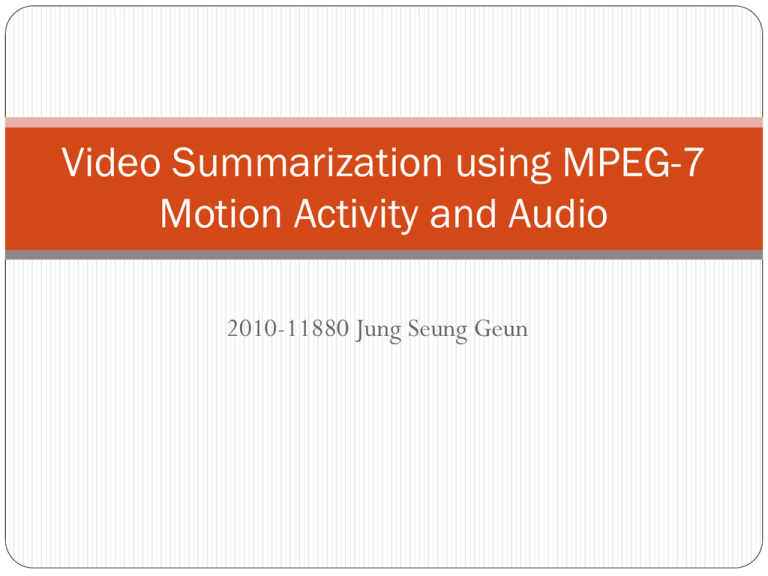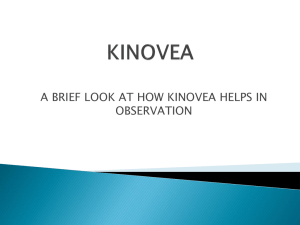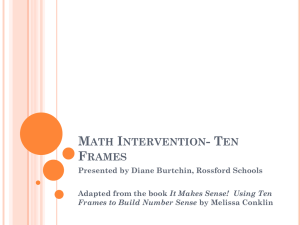Video Summarization using MPEG
advertisement

Video Summarization using MPEG-7 Motion Activity and Audio 2010-11880 Jung Seung Geun Qeustion Overview of ‘Video Summarization’ “Video summarization methods attempt to abstract the main occurrences, scenes, or objects in a clip in order to provide an easily interpreted synopsis Video is time-consuming to watch „Much low-quality video Huge increase in video generation in recent years From http://www.cs.utexas.edu/~grauman/courses/spring2008/slides/Video_Su mmarization.pdf Introduction Past works on video summarization has mostly employed color descriptors, with some work on video summarization based on motion features. Writer’s motivation is computational simplicity and easy incorporation into consumer hardware. Therefore, they focused on feature extraction in the compressed domain. Motion activity Descriptor The MPEG-7 motion activity descriptor attempts to capture human perception of the “intensity of action” or the “pace” of a video segment. For instance, a goal scoring moment in a soccer game would be perceived as a “high action” sequence by most human viewers. However, a “head and shoulders” sequence of a talking person would certainly be considered a “low action” sequence. Motion activity Descriptor (cont.) The MPEG-7 Motion activity descriptor has been found to accurately capture the entire range of intensity of action in natural video. It uses quantized standard deviation of motion vectors to classify video segments into five classes ranging from very low to very high intensity. Key frame Definition - A drawing that defines the starting and ending points of any smooth transition. A sequence of key frames defines which movement the viewer will see. However, as the motion becomes higher, the first frame is increasingly unacceptable as a key frame. Key frame extraction from Shots And initial approach to key frame extraction was to choose the first frame of a shot as the key frame. It is a reasonable approach and works well for los-motion shots. However, as the motion becomes higher, the first frame is increasingly unacceptable as a key frame. Key frame fidelity The fidelity measure is defined as the Semi-Hausdorff distance between the set of key frames S and the set of frames R in the video sequence. Most existing dissimilarity measures satisfy the properties required for the distance over a metric space used in the above equation. Motion activity as a Measure of Summarizability Writer hypothesize that since high or low action is in fact a measure of how much a video scene is changing, it is a measure of the “Summarizability” of the video scene. Car chase has more “changes” in it compared to say a news anchor shot. Unfortunately, there are no simple objective measures to text such a hypothesis. However, since change in a scene often involves change in the color characteristics as well. Motion activity as a Measure of Summarizability (cont.) They first try to investigate the relationship between color based fidelity. Let the key frame set for shot A be and that for shot B be . If and has same number of key frames, then the hypothesis is that if the intensity of motion activity of shot A is grater than the intensity of motion activity of B, then the fidelity of is less than the fidelity of . Establishing the Hypothesis They extract the color and motion features of news video programs from the MPEG-7 test set and segment the program into shots. For each shot, they then extract the motion activity features from all the P-frames by computing the standard deviation of motion vector magnitudes of macro blocks of each P frame, and a 64 bin RGB Histogram from all the I frames, both in the compressed domain. Establishing the Hypothesis (cont.) Then, they compute the motion activity descriptor for each I frame by averaging those of the previous P frames in the Group of Pictures. The motion activity of the entire shot is got by averaging the individual motion activity values computed above. For simplification they used the first frame as a single key frame and computed its fidelity. Empirically that a key frame with Semi-Hausdorff distance at most 0.2 is of satisfactory quality. Establishing the Hypothesis (cont.) We thus find experimental evidence that the summarizability of the shots goes down as their motion activity goes up. A Motion Activity based Non-Uniform Sampling Approach to Key Frame Extraction Intensity of motion activity is indeed a measure of the change from frame to frame. Then, the cumulative intensity of motion activity must be a good indication of the cumulative change in the content. As picking the first frame as a key frame is disadvantageous, writer was motivated to find a better single key frame based on motion activity. A Motion Activity based Non-Uniform Sampling Approach to Key Frame Extraction (cont.) If each frame represents an increment in information then the last frame at the maximum distance from the first. That would imply that the frame at which the cumulative motion activity is half the maximum value is the best choice for the first key frame. When writer used this new key frame, it out performed the first frame as illustrated in Figure which we saw 2 pages before. A Motion Activity based Non-Uniform Sampling Approach to Key Frame Extraction (cont.) This motivates them to propose a new nearly optimal strategy. To get n key frames, devide the video sequence into n equal parts on the cumulative motion activity scale. Then use the frame at the middle of the cumulative motion activity scale of each of the segments as a key frame, thus getting n key frame. Note that these n key frame extraction strategy scales linearly. A Motion Activity based Non-Uniform Sampling Approach to Key Frame Extraction (cont.) Writer’s criterion of acceptable fidelity combined with the n frame strategy enables a simple and effective solution to the two basic problems of key frame extraction. 1. How many key frames does a shot require for acceptable fidelity? 2. How do we generate the required number of key frames? A Simple Progressive Modification Progressive key frame extraction is important for interactive browsing since the user may want further elaboration of summaries that he has already received. Since Writer’s key frame extraction is not progressive, they propose a progressive modification of their technique. They started with the first frame, and then choose the last frame as the next key frame because it is at the greatest distance from the first frame. They carry this logic forward as they compute further key frames by choosing the middle key frame in cumulative motion activity space as the third key frame, and so on recursively. A Simple Progressive Modification (cont.) The modified version is slightly inferior to original technique but has the advantage of being progressive. In Figure above they illustrated a typical result. Constant Pace Skimming Using Motion So far, I said that intensity of motion activity(or pace) of a video sequence is a good indication of its “summarizability”. Here they build on this notion by adjusting the playback frame rate of the temporal sub sampling rate. The pace of the summary serves as a parameter that enables production of a video summary of any desired length. Constant Pace Skimming Using Motion (cont.) Either the less active parts of the sequence are played back at a faster frame rate or the less active parts of the sequence are sub sampled more heavily than are the more active parts, so as to produce a summary with constant pace. The basic idea is to skip over the less interesting parts of the video. Constant activity sub sampling or activity normalized playback A brute force way of summarizing video is to play it back at a faster than normal rate. This can also be viewed as uniform sub sampling. Such a fast playback has the undesirable effect of speeding up all the portions equally thus making the high motion parts difficult to view, while not speeding up the low motion parts sufficiently. Constant activity sub sampling or activity normalized playback (cont.) Thus, the low activity segments would have to be speeded up considerably to meet the required level of motion activity, while the high activity segments would need significantly less speeding up if at all. This can be viewed as adaptive playback speed variation based on motion activity, or activity normalized playback. Another interpretation could be in terms of viewability or “perceptual bandwidth”. The most efficient way to play the video is to make full us of the instantaneous perceptual bandwidth, which is what the constant activity playback achieves. Constant activity sub sampling or activity normalized playback (cont.) To achieve a specified activity level while playing back video, they need to modify the activity level of the constituent video segments. Writer first make the assumption that the intensity of motion activity is proportional to the motion vector magnitudes. Hence they need to modify the motion vectors so as to modify the activity level. There are two ways that they can achieve this Constant activity sub sampling or activity normalized playback (cont.) 1. Increasing/Decreasing the Playback Frame rate. From writer’s earlier assumption, the intensity of motion activity increases linearly with frame rate. We can therefore achieve a desired level of motion activity for a video segment as follows. Playback frame rate = (Original Frame rate) * (Desired level of motion activity/original level of motion activity) Constant activity sub sampling or activity normalized playback (cont.) 2. Sub Sampling the video sequence. Another interpretation of such playback is that it is adaptive sub sampling of the frames of the segment with the low activity parts being sub sampled more heavily. This interpretation is especially useful if we need to summarize remotely located video, since we often cannot afford the bandwidth required to actually play the video back at a faster rate. In both case above, Summary length = (Sum of frame activities)/(desired activity) Constant activity sub sampling or activity normalized playback (cont.) The most obvious choice to specify the measure of motion activity is “The average motion vector magnitude”. “The average motion vector magnitude” provides a convenient linear measure of motion activity. Decreasing the allocated playing time by a factor of two, for example, doubles the average motion vector magnitude. Constant activity sub sampling or activity normalized playback (cont.) “The average motion vector magnitude of the input video of N frames can be expressed as Where the average motion vector magnitude of frame I is . For a target level of motion activity in the output video, the relationship between the length of the output video and the length of the input video can be expressed as Constant activity sub sampling or activity normalized playback (cont.) However, playing back at a desired constant is only possible in theory. In practice, it would require interpolation of frames or slowing down the playback frame rate whenever there are segments that are higher in activity than the desired level. Such interpolation of frames would be computationally intensive and difficult. Furthermore, such an approach does not lend itself to generation of a continuum of summary lengths that extends from the shortest possible summary to the original sequence itself. Constant activity sub sampling or activity normalized playback (cont.) The preceding discussion motivates writer to change the sampling strategy to achieve a guaranteed minimum level of activity as opposed to a constant level of activity, so they are able to get a continuum of summaries ranging from the sequence being its own summary to a single frame summary. With the guaranteed minimum activity method, they speed up all portions of the input video that are lower than the targeted motion activity so that they attain the targeted motion activity using the above formulation. Constant activity sub sampling or activity normalized playback (cont.) The length of the output video using the guaranteed minimum activity approach can be determined as follows. First, classify all of the frames of the input video into two sets. A first set includes all frames j where the motion activity is equal to or higher than the targeted minimum activity. The second set includes all frames k where the motion activity is lower than the targeted motion activity. Constant activity sub sampling or activity normalized playback (cont.) Then the length of the input video is expressed by The average motion activity of frames j that belong to the set is And the length of the output converted is How fast can you play the video? The temporal Nyquist rate limits how fast a video can be played without becoming imperceptible by a human observer. A simple way of visualizing this is to imagine a video sequence that captures the revolution of a stroboscope. At the point where the frame rate is equal to the rate of revolution, the stroboscope will seem to be stationary. Thus, the maximum motion activity level in the video segment determines how fast it can be played. Experimental Procedure, Results and Discussion The top row shows a uniform sub-sampling of the surveillance video, while the bottom row shows an adaptive sub-sampling of the surveillance video. Note that the adaptive approach captures the interesting events while the uniform sub-sampling mostly captures the highway when it is empty. The measure of motion activity is the average motion vector magnitude in this case. Experimental Procedure, Results and Discussion (cont.) The constant pace skimming is especially useful in surveillance and similar application in which the shots are long and the background is fixed. Note that in such applications, color-based techniques are at a disadvantage since the semantics of the interesting events are much more strongly related to motion characteristics than to changes in color. Experimental Procedure, Results and Discussion (cont.) Page 105 Experimental Procedure, Results and Discussion (cont.) The foregoing discussion on sports video indicates that the key to summarizing sports video is in fact in identifying interesting events. This motivates writer to investigate temporal patterns of motion activity that are associated with interesting events. For news video, it works best when the semantic boundaries of the content are known. This motivates them to investigate automatic news video semantic, or topic, boundary detection using audio features. Audio assisted news video browsing The key frame based video summarization techniques are evidently restricted to summarization of video shots. The news video in particular consists of several distinct semantic units, each of which in turn consists of shots. Therefore it would be much more convenient to somehow choose the semantic unit of interest and then view its key frame based summary in real-time, than to generate a key frame based summary of the entire video sequence and then look for the semantic unit of interest in the summary. Audio assisted news video browsing (cont.) If a topic list is available in the content meta-data, then the problem of finding the boundaries of semantic units is already solved. However if the topic list is unavailable, as is the case more often than not, the semantic boundaries are no longer readily available. We then need to extract the semantic/topic boundaries automatically. Audio assisted news video browsing (cont.) Thus knowing the topic boundaries enables the user to skim through the news video from topic to topic until he/she has found the desired topic. News anchor detection has been carried out using color, motion, texture and audio features. For example Wang et al carry out a speaker separation on the audio track and then use the visual or video track to locate the faces of the most frequent speakers or the “principal cast”. Audio assisted news video browsing (cont.) Speaker separation and principal cast identification provide a solution to the problem of topic boundary detection. Unfortunately, the proposed methods in the literature are highly complex in computation and hence do not lend themselves well to consumer video browsing systems. Proposed Principal Cast Identification Technique Proposed Principal Cast Identification Technique 1. Extract motion activity, color and audio features from the News video. 2. Use the sound recognition and clustering framework to find speaker changes. 3. Use motion and color to merge speaker clusters and to identify principal speakers. The locations of the principal speakers provide the topic boundatirs. 4. Apply the motion based browsing described before to each topic. (page 108) Speaker change detection using sound recognition and clustering The input audio from broadcast news if broken down into sub-clips of smaller durations such that they are homogenous. The energy of each sub-clip is calculated so as to detect and remove silent sub-clips. MPEG-7 features are extracted from non-silent sub-clips and are classified into one of the three sound classes namely male, female, and speech with music. Speaker change detection using sound recognition and clustering (cont.) At this point, all make and female speakers are separated. Median filtering is performed to eliminate spurious changes in speakers. In order to identify individual speakers within male and female sound class, an unsupervised clustering step is performed based on the MPED-7 state duration histogram descriptor. Each sub-clip is then associated with a state duration histogram descriptor. Second level of clustering using motion and color features Since clustering is done only on contiguous male/female speech segments, we achieve speaker segmentation only in that portion of the whole audio record of the news program. A second level of clustering is required to establish correspondences between clusters from two distinct portions. Motion and color cues extracted from the video can be used for the second level of clustering. Second level of clustering using motion and color features (cont.) Once the clusters have been merged, it is easy to identify principal cast and hence semantic boundaries. Then, the combination of the principal cast identification and motion-based summary of each semantic segment enables quick and effective browsing of the news video content. Experimental Procedure and results Data-set : 90%-10% training/testing set for cross-validation. News1, News2. (page 111~112) Future Work 1. Improving the audio classification using more extensive training. 2. further improve clustering of audio. 3. further refine the combination of motion activity and color to increase the reliability of principal cast identification. Sports Highlight detection 1. Improving the audio classification using more extensive training. 2. further improve clustering of audio. 3. further refine the combination of motion activity and color to increase the reliability of principal cast identification.








